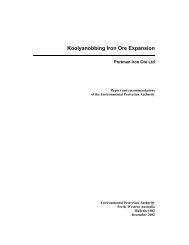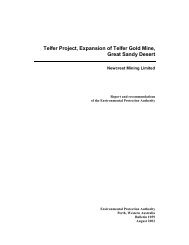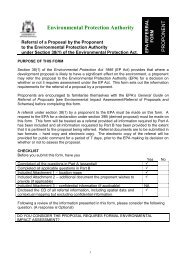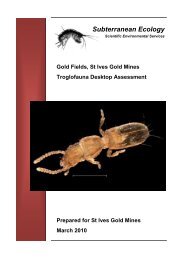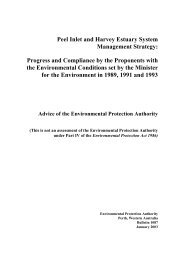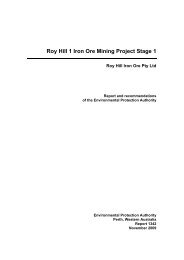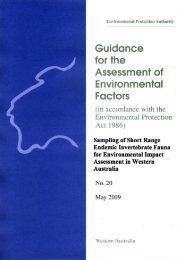Flora survey for Hamersley Drive recreation - Environmental ...
Flora survey for Hamersley Drive recreation - Environmental ...
Flora survey for Hamersley Drive recreation - Environmental ...
Create successful ePaper yourself
Turn your PDF publications into a flip-book with our unique Google optimized e-Paper software.
FRNP Improvement Project: Culham Inlet to <strong>Hamersley</strong> Inlet GF Craig– July 2010<br />
Analysis of data<br />
Tracks and waypoints were downloaded from the GPS units using OziExplorer® software. Tracks and<br />
waypoints were saved as .plt/.wpt and .txt files (UTM/UPS and hddd.ddddd o ), the latter allows importing<br />
of data into Excel® spreadsheets.<br />
Plant species were recorded in a MAX V3 data table, a software program developed by DEC’s Western<br />
Australian herbarium which links datasets to the Census of Western Australian Plants master list. The<br />
‘relevé number’ was entered into the database.<br />
To assist in clarifying the vegetation units, Anne Rick used PRIMER® multivariate analysis to produce<br />
dendrograms that grouped relevés on the basis of species similarity. Both Newbey’s (Chapman and<br />
Newbey 1987) and the author’s data were included in the analysis. Only perennial species were<br />
included, and <strong>for</strong> the Newbey data, only those species with > 0.5 abundance. Relevés with only a few<br />
species recorded were excluded as they skewed the data.<br />
Once the vegetation units had been clarified using the PRIMER® analysis, species lists <strong>for</strong> each unit<br />
were prepared. Vegetation units were mapped using a combination of field data, PRIMER® analysis<br />
and interpretation of orthophotos.<br />
Digitising<br />
Digital files including waypoints of each species of threatened flora encountered during the <strong>survey</strong> and<br />
line work of the vegetation map (1:10 000 scale) were sent to Meredith Spencer in 2009 and Janet<br />
Newell in 2010 (DEC Albany) <strong>for</strong> digitising. Final maps were provided as shapefiles <strong>for</strong> compatibility<br />
with ArcMap.<br />
3. Desktop Assessment<br />
Physical Environment<br />
Climate<br />
A Mediterranean climate of warm to hot summers and cool, wet winters is generally experienced. The<br />
nearest weather station is Hopetoun North, <strong>for</strong> which the last 13 years of data is available (Table 1).<br />
Mean maximum temperature recorded at Hopetoun in the hottest month (February) is 26 o C. Mean<br />
minimum temperature in the coldest months (July-August) is 8 o C. The highest recorded temperature of<br />
48 o C was recorded on 6 January 2010, while the lowest of -0.3 o C was in July 2000. Frosts have been<br />
recorded by farmers in the catchment during winter and spring, but are usually rare on the coast.<br />
The rainfall is typical of a Mediterranean climate with a pronounced winter maximum and a long dry<br />
summer. The mean annual rainfall on the coast is about 500 mm, but has been highly variable over the<br />
past 10 years with the maximum of 610 mm in 2001, followed by a very dry year in 2002 when only<br />
274 mm fell. Sporadic heavy rainfall events can occur in summer as a result of cyclonic events in the<br />
north of the State - the highest monthly rainfall of 185 mm was recorded in January 2000.<br />
Annual evaporation is generally 1500 mm.<br />
Morning wind speeds are typically 17-22 km/h and increase in the afternoon to average 20-29 km/h. On<br />
the hottest recorded day, i.e. 6 January 2010, the strong winds from the NNW had only 5% Relative<br />
Humidity at 3 pm (BOM, 2010), the strongest wind gust was not recorded!<br />
Climate Change is predicted to impact the south coast of Western Australia. Changes in temperature<br />
and rainfall patterns may lead to changes in the physical condition of the region and to the growing<br />
season, incidence of frost and flood events etc.<br />
5



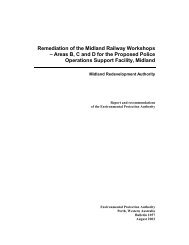
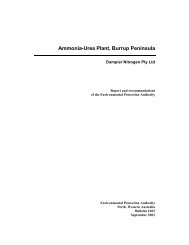
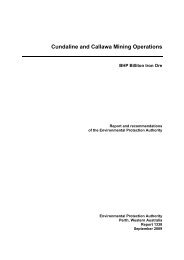
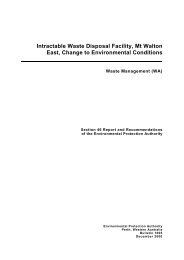
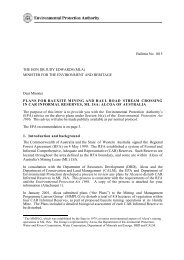
![[Project Title] - Environmental Protection Authority - The Western ...](https://img.yumpu.com/29001740/1/184x260/project-title-environmental-protection-authority-the-western-.jpg?quality=85)
